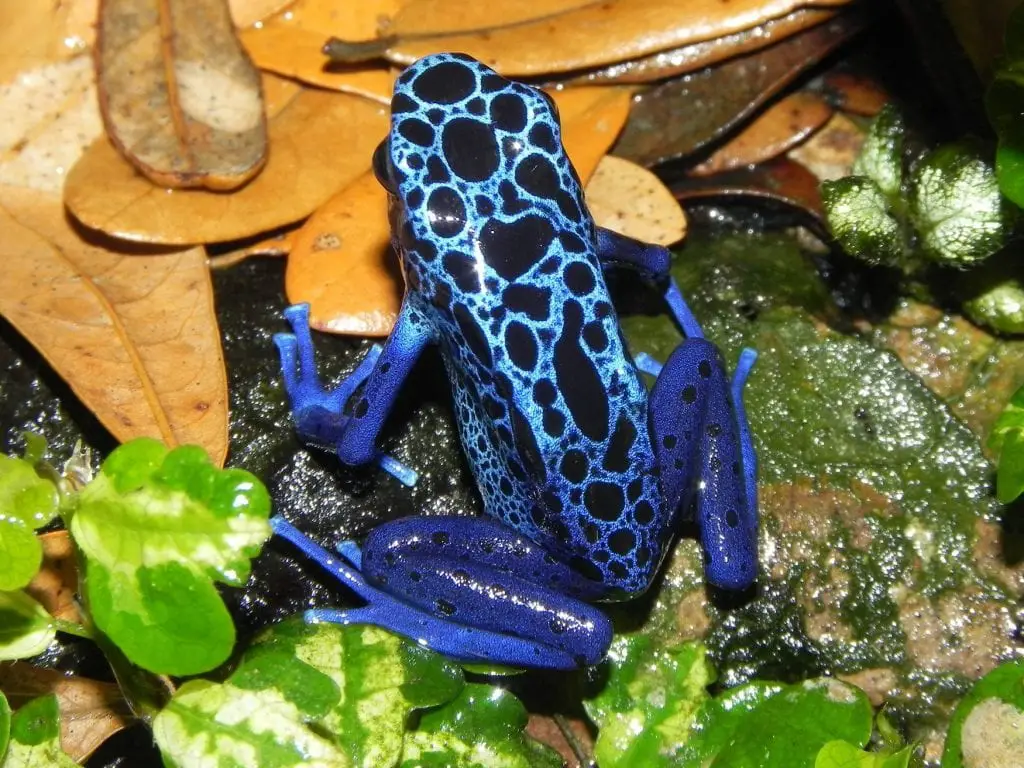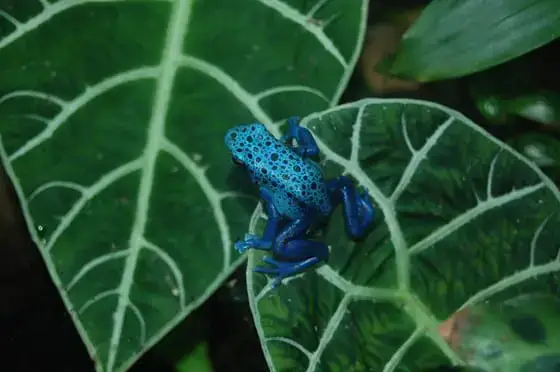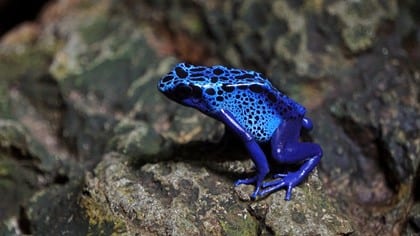How Does the Snake Eat the Blue Poison Dart Frog

Image Source
Scientific name: Dendrobates tinctorius "azureus"
Also known as: Blue poison arrow frog, Okapipi or Okopipi (native Tirio Indian name)
Fact #1: This beautiful, azure tropical frog is quite small
The blue poison dart frog is one of the most beautiful but dangerous animals in the world. This small tropical amphibian reaches a length of approximately 3 to 5 cm, and typically weighs 3 to 8 grams. The bright blue skin, covered in patterns of black specks and patches, is their trademark of these dangerous little frogs. Their beauty is sometimes compared to that of a sapphire. The black spots are arranged irregularly along their back and head.
Fact #2: No two blue dart poison frogs are identical
Interestingly, the skin patterns are unique to each frog — no two frogs look exactly the same. It serves as a personal 'fingerprint'. The skin around the stomach and the legs is usually in a darker shade of blue. It is smooth, except for the thighs, where it is usually granular.
Fact #3: The blue dart poison frog has a repugnant taste
Blue poison dart frogs send a strong aposematic signals to ward off predators and territory intruders. This signaling includes a display of a vibrantly-colored body, as well as sending out certain warning sounds. The blue skin is this little frog's best defense mechanism — covered in glands that secrete strong poisons, it can paralyze or kill predators. The blue color signals danger to certain predators, and those who still dare to attack are not awarded with a treat. Scientists state that, due to the poison, these frogs taste unpalatable or even repugnant.
In a recent study, scientists suggest that the blue-black color pattern serves one more purpose — it is a camouflage that allows the frog to blend-in with its surrounding.
Fact #4: Male blue poison dart frogs have heart-shaped toe tips and a hunch back
Blue poison dart frogs have four toes on their front feet and five on their back ones. The males can be recognized by their larger, heart-shaped toe tips and hunch-back pose. The females have slightly larger body and round toe tips. Their feet are not webbed, but they have a strong grip due to a well-developed suction cup pad.
Fact #5: The blue poison dart frogs were discovered only 50 years ago
Another interesting fact is that the blue poison dart frog was discovered relatively late — in 1968 — in the remote rainforest islets in the Sipaliwini Savannah of southern Suriname.
Blue poison dart frogs are found only in a few isolated tropical rainforests of Suriname, French Guiana and northern Brazil. Their natural habitat is warm and humid, with daily temperatures in the range of 22 to 27º C and nightly around 20º C.
Fact #6: The blue poison dart frogs owe their name to an indigenous hunter practice
The name of the species comes from the use of their poison by the Native tribes. Local hunters use darts dipped in the poison to quickly kill animals for food. However, only the yellow (golden) dart frog species have been used for this purpose.

Image Source
Fact #7: The blue poison dart frogs are terrible swimmers, but excellent tree climbers
Blue poison dart frogs express their territorial behavior by warning away the intruder first, followed by chasing and wrestling with the competitor. They are never found in the water — since they do not possess webbed feet (there is no membrane between their toes), they cannot swim well. They hide among stones, debris and moss close to water bodies, or under the dense carpet of tree leaves in the forest. Unexpectedly, blue poison dart frogs have even been found on trees, up to a height of 5 m.
They are diurnal (mostly active during the daytime). Since they mostly rely on the color of their skin as protection from predators, they remain inactive during the night, when their defense mechanism becomes ineffective.
Fact #8: The blue poison dart frogs live longer in captivity than in the nature
The life expectation of the blue poison dart frogs is between four and six years when they are in their natural habitat. In captivity (kept either as pets or as ZOO animals), their lifespan extends significantly — usually up to ten years. The oldest reported blue poison dart frog lived for 12 years in captivity.

Image Source
Fact #9: The female blue poison dart frogs often fight over a male
Blue poison dart frogs reach sexual maturity at the age of two. Their breeding period is in late winter (February-March), during the rainy season. Sitting on a rock or a leaf, the male makes a quiet call as a part of the courtship ritual. The males are in demand — it often happens that two or more females fight over a male. The one who wins, touches the male with her front legs, nudges him and sometimes even wrestles with him. The fertilization is external.
The female chooses her mate's territory for laying eggs. The eggs are laid in sheltered moist and mossy areas, well-protected by logs and rocks. There are 5-10 eggs in each clutch.
Fact #10: The male blue poison dart frog carries his cannibalistic tadpoles on his sticky hunched back
The male exhibits a very peculiar behavior during the mating period. In addition to being aggressively protective over the eggs, the male keeps the eggs moist. Once the eggs hatch (two weeks after they have been laid), the male separates the aquatic larvae. He carries them on the sticky skin of his back, and places them at different water points (wet tree holes, bromeliad or small pools). This prevents the tadpoles from eating each other. The size of the tadpoles is 1 cm, with a 6 mm long tail. From that point onwards, the female takes the responsibility of feeding the tadpoles. She feeds them with unfertilized eggs. It takes them 2.5 to 3 months to metamorphose into froglets and begin independently their semi-terrestrial or terrestrial life.
Fact #11: The blue poison dart frogs get their poison from the food they eat
Blue poison dart frogs are insectivores. They feed on small insects such as ants, termites, flies, beetles, caterpillars and spiders. These frogs have excellent eyesight, sense of smell, and a long sticky tongue to employ while hunting for insects. Through this arthropod-based diet they consume lipophilic alkaloids, which help them develop high concentration of toxins on their skin. The frogs do not have biological mechanisms to directly synthesize toxins.
Fact #12: The fire-bellied snake, endemic to Suriname, is resistant to the blue dart frog's poison
Tadpoles have no poison and often become food to dragonfly larvae. Adult blue poison dart frogs fall prey to snakes and big spiders. The fire-bellied snake (leimadophis epinephelus) is immune to the poison of the blue poison dart frog.
Fact #13: The blue poison dart frogs lose their toxicity when held in captivity
Blue poison dart frogs are popular home pets in the United States of America. Since in captivity their diet changes significantly (fruit flies, crickets, springtails and worms), their poison loses strength. Still, it is not recommended touching their skin. Its toxins can cause pain, cramping and stiffness. Ingesting a blue poison dart frog can be fatal to humans. No 'death by touch' case has ever been reported.

Image Source
Fact #14: The blue poison dart frogs are on the IUCN Red List of Threatened Species
Blue poison dart frogs are endemic to the tropical forests of Suriname. They are classified as a vulnerable species under the IUCN Red List of Threatened Species. Due to the remoteness of their natural habitat, monitoring their population trends becomes quite challenging.
Fact #15: Many captive-breeding programs have successfully curbed the illegal trade of blue poison dart frogs
Forest fire and drought is the greatest threat to their survival. They are also vulnerable to pollution, fungal diseases and habitat destruction to illegal construction activities. Illegal wildlife trade does not pose a great risk, since there are many successful captive-breeding conservation programs across legal networks of Zoos and aquariums.
Fact #16: The blue poison dart frog can turn a green-feathered parrot into a red-feathered one
Blue poison dart frogs have been used in local tribal rituals. Animal Diversity reports of a curious practice performed by indigenous peoples of Suriname. First, they pluck the feathers from a common green-fathered parrot. Second, they rub a blue poison dart frog onto the bare skin of the bird. Finally, they wait for the parrot to grow new feathers, which turn our red.
Fact #17: The blue poison dart frogs could one day provide valuable medicines
The poison obtained from the blue dart frog has the potential to cure. Scientists are already studying the biology of the poison dart frogs in a hope to find new applications. In the past, molecules developed from animal toxins or poisons have been efficiently used in the treatment of various illnesses, including diabetes, hypertension and chronic pain. Therefore, the medical and pharmaceutical industries could greatly benefit from such a discovery.
Source: https://slightlyblue.com/nature/blue-poison-dart-frog-facts/
0 Response to "How Does the Snake Eat the Blue Poison Dart Frog"
Post a Comment